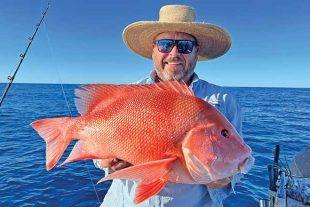
THE transition months where both warm and cool water species are on offer can produce red-hot fishing action.
Fish that prefer warmer water such as mangrove jack will be feeding hard at this time before the water temperature rapidly drops in May. Some of the best jack fishing occurs during the season transition, with a lot of big fish over 50cm landed and lost. Good areas to look at this month are bridge pylons, deep holes and deep rock walls.
Bait fishing with live baits, pilchards and mullet fillets presents the most consistent way to land jacks, but it’s more rewarding catching them on lures. Mangrove jack can be very destructive to inferior lures and hardware. Remember to replace any weak hooks and split rings before attempting to land a jack. It can take hours to get a bite from a jack some days and the last thing you want to go wrong when the hooks find the mark is gear failure.
The by-catch can be good when chasing jacks during the season transition, with estuary cod, trevally, barramundi, flathead, sharks and Queensland groper all possible. Rain has continued to fall and kept the rivers and creeks around Brisbane quite dirty. This has pushed the bait out from the upper reaches and we should see good action on a variety of species during April.
Flathead numbers will increase this month. It can be difficult to find flatties in numbers during the warmer months and their size is generally pretty average too. If you can find an area holding prawns that isn’t being cast netted, a few flathead will be hanging around. Soft vibes and plastics jigged through the deeper holes work well.
The Brisbane River will be the pick of the spots around Brisbane in the April transition. Good schools of threadfin salmon and jewfish are around the Port of Brisbane towards the mouth. Some of the schools are the largest most anglers have seen for many years, which is a really good sign. A quality sounder is a huge help when fishing a big river like the Brissie.
A unit with a side-scanning feature will save a lot of time when looking for fish along the wharves. It’s not uncommon to sound a large stretch without seeing a fish. They seem to move in and out from under the wharves among the pylons and it can be nearly impossible to know when they will emerge.
I don’t go out of my way to chase threadfin salmon in the deep water. I find them way too difficult to release well. Bombing them back to the bottom with a release weight is probably the most effective method, but the way the sharks are honed into boats sitting on fish these days, I doubt many threadies survive anyway.
Luckily they are superb eating, even though they’re a bit of a nightmare to fillet. There’s nothing wrong with keeping one for the table, but sitting on the fish and catching a heap doesn’t do the fishery any favours.
Snapper should be in good number in the river during the season transition. Some good-quality fish over 60cm inhabit the river at times. They put up a hell of a fight when hooked around structure. I’ve been smoked plenty of times when fishing lighter gear. I find snapper really like fluoro plastics in the river. Prawn imitations and paddle tails in 3”-4” sizes work really well.
Mud crabs have been on fire. Some of the rivers are still quite dirty and lots of crabs have been on the move. Filtering through undersize males and females has been a mission, but well worth the effort. You’ve got heaps of options to choose from during the season transition, so get out there and into the fish.
I hope to see you on the water.
 Bush 'n Beach Fishing Magazine Location reports & tips for fishing, boating, camping, kayaking, 4WDing in Queensland and Northern NSW
Bush 'n Beach Fishing Magazine Location reports & tips for fishing, boating, camping, kayaking, 4WDing in Queensland and Northern NSW








